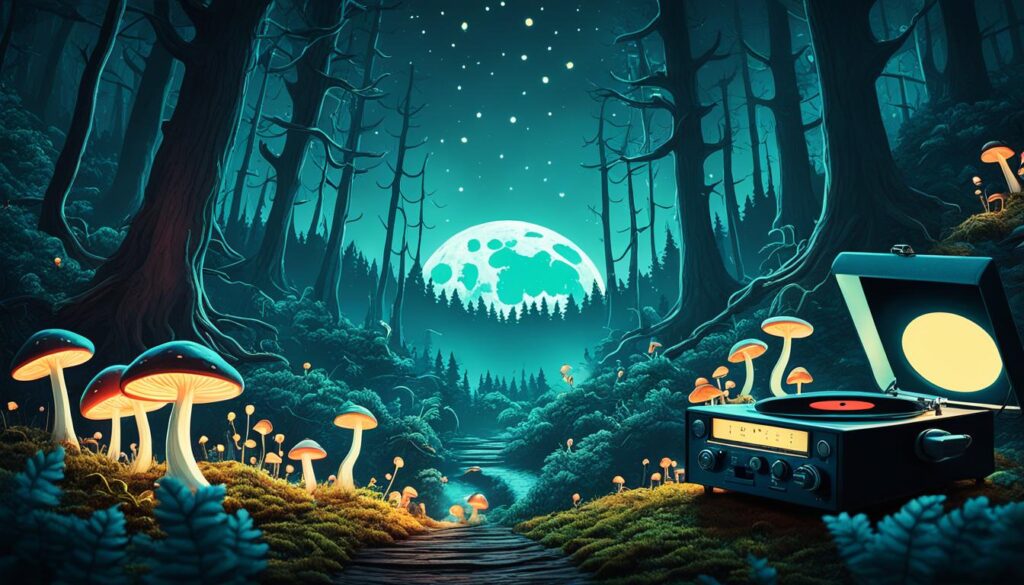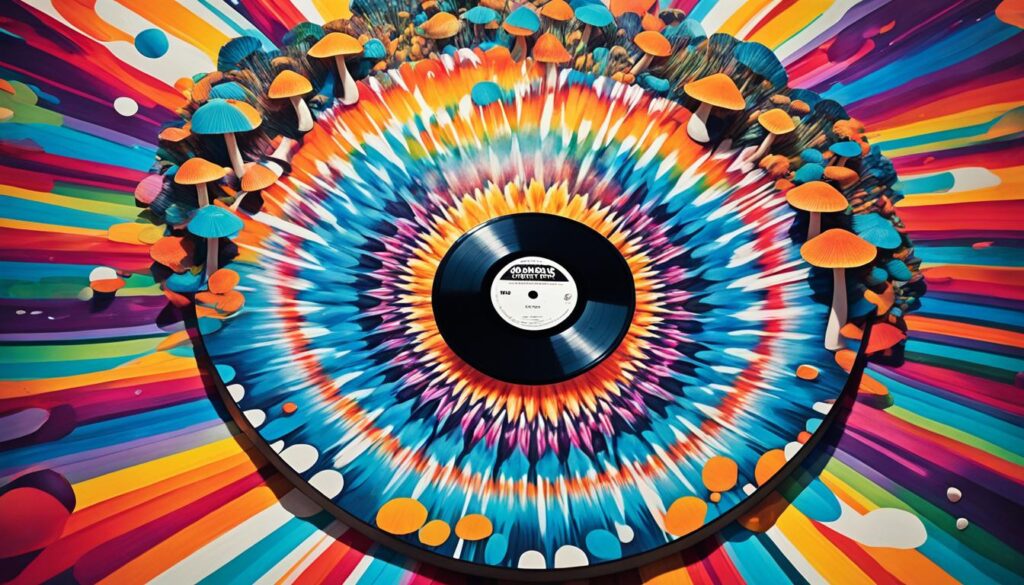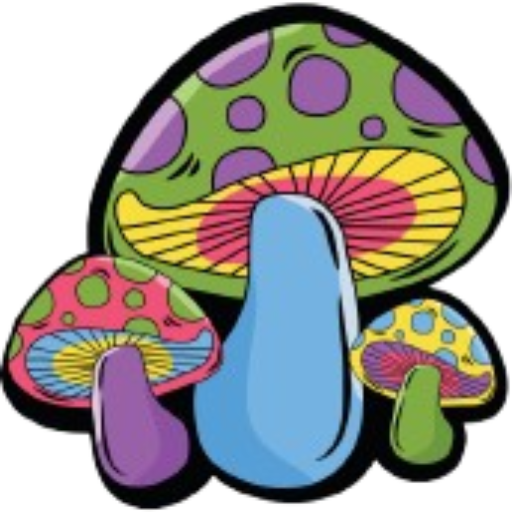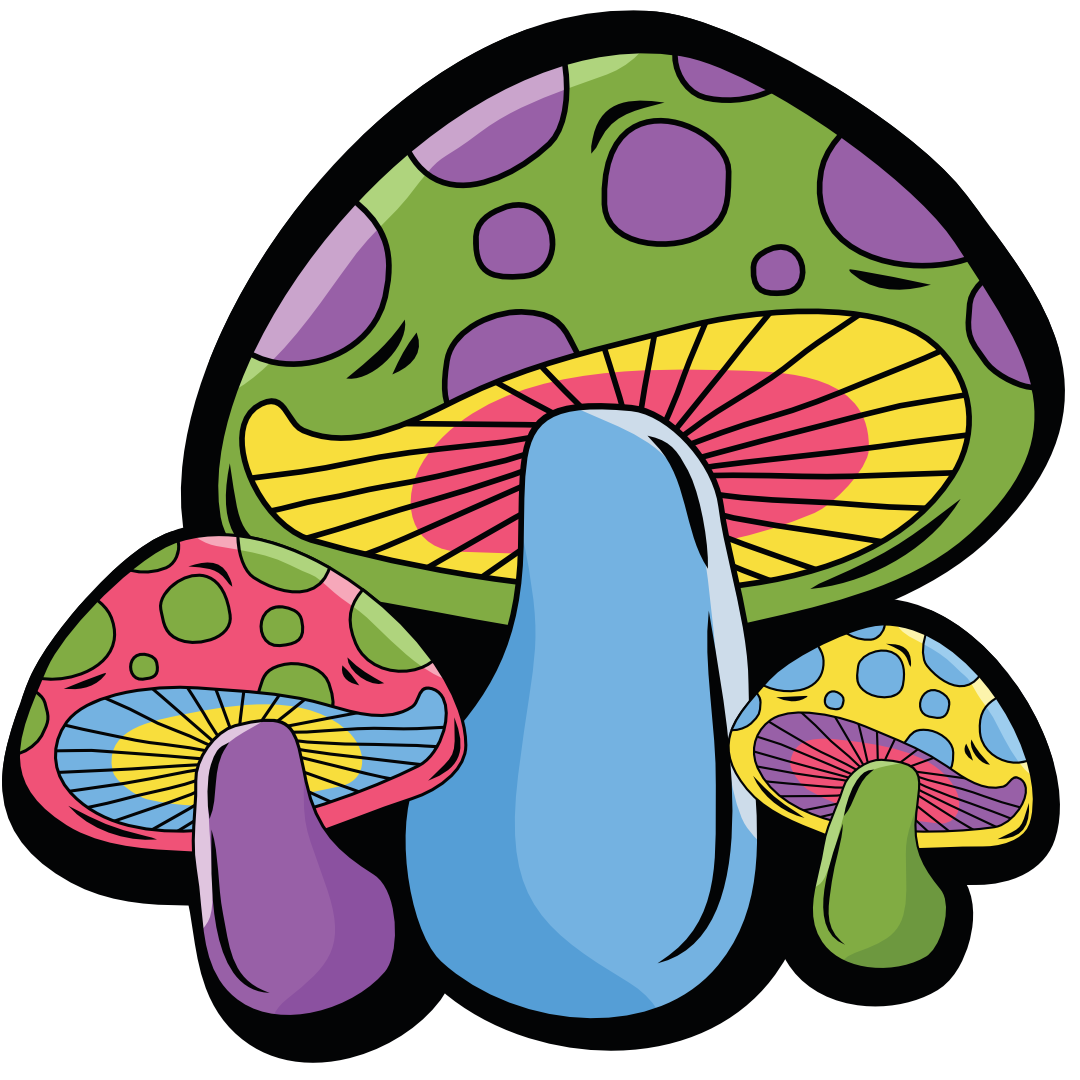Recently, Henryk Gorecki’s Symphony No. 3 took Rob Jacobs back to a life-changing psilocybin experience from a decade ago. Jacobs was lying on a couch at Johns Hopkins, wearing eyeshades, feeling a deep emotional connection to the music. This moment inspired Bill Richards, a psychologist and researcher, to create a special playlist1.
Bill Richards has spent over 57 years studying psilocybin1, starting in 19631. His “Sacred Knowledge” playlist, made in 19671, helps people on their psilocybin journeys. Since psilocybin’s effects last 5-7 hours1, the playlist matches the feelings and experiences of the trip.
The Power of Music on Psychedelic Journeys
Bill Richards, a psychologist since 19632, talks about the key to a good psychedelic experience. He says having the right music is crucial. Richards even made a playlist called “Psilocybin Research” for his work with patients2.
Insights from Psychedelic Researcher Bill Richards
Richards believes music doesn’t shape the trip itself. But it sets the stage for the experience. He calls it a “nonverbal support system” for the user2. This support is vital during the 5-7 hour psilocybin trip2.
Music as a Nonverbal Support System
Richards suggests avoiding songs with lyrics at first. Music acts as a “nonverald support system” for the trip2. He carefully picks songs to match the different stages of the trip, from start to end2.
One study participant found the playlist deeply moving. It showed how music can change a psychedelic journey2. Richards advises doing your homework before trying psychedelics and seeing a pro2.
“The music doesn’t define the trip, but rather constructs the space in which the user’s trip will function, acting as a ‘nonverbal support system’ for the participant.”
Apps like Wavepaths, Lucid, Spiritune, and Mindcure now help tailor music for psychedelic therapy3. These apps use AI and human composers to make music for therapy3. Field Trip uses Wavepaths to make music that matches a person’s feelings and goals3.
Mindcure and Lucid use special devices to track how people feel and adjust the music on the spot3. During the pandemic, people started to explore more psychedelic music for their trips32.
The Making of the “Psilocybin Research” Playlist
The “Psilocybin Research” playlist started in 1967 with Bill Richards at the Spring Grove Hospital Center4. Over time, Richards and Helen Bonny, a music therapist, worked together on it. Brian Richards, Bill’s son, also helped.
Classical Music and Its Ability to Guide Experiences
Classical music was chosen for the playlist because it helps guide the psychedelic experience45. Richards says that music without words lets the mind focus on deep thoughts, not just the words.
The Purposeful Exclusion of Lyrics
Richards left out music with words to keep the mind from getting caught up in lyrics4. This way, the playlist helps people have a deeper, more thoughtful experience with psilocybin.
“Music resonating with the patient’s experience supports self-exploration during the psychedelic journey.”4
The “Psilocybin Research” playlist is made to help with the effects of psilocybin5. It’s a key tool for guiding people through their psychedelic experiences.
Making a Music Playlist for Mushroom Trips
The Importance of Set and Setting
Preparing for a psychedelic trip means focusing on “set” and “setting”. Set is your mindset and feelings, while setting is the place you’re in6. Bill Richards, a psychedelic researcher, says music is key in shaping the setting. He believes it helps people reach deep states of consciousness for healing.
Creating a safe, cozy, and intentional space is key for a good mushroom trip7. Trips can last 4 to 6 hours, sometimes longer. Having playlists for different trip phases helps make it better7.
Music that means something to you can make the trip better, as studies show8. Places like Johns Hopkins University and Imperial College London have made special playlists for research and therapy. They offer a mix of genres for everyone7.
If you’re making your own playlist, think about your taste and the trip’s phases8. Mixing music with mushrooms can make the experience safer and deeper8.
“Music has been traditionally used in almost every indigenous culture in the world in combination with altered states of consciousness.”8
The Playlist Structure and Its Significance
The “Psilocybin Research” playlist is carefully made to match the different stages of a psychedelic trip9. Bill Richards, a psychologist, started his psychedelic research in 1963. He designed the playlist to help and support people on their journey9.
Onset, Peak, and Post-Peak Phases
The playlist has special parts for the onset, peak, and post-peak phases of the trip10. At the start, the music is gentle and keeps moving, helping people get into the new state of mind. When the trip peaks, the music slows down to help people feel more stable9.
Then, the playlist changes to happy, familiar tunes to help people come back to reality9.
This careful planning helps people move through the psychedelic journey smoothly, with the right music for each step9. The playlist aims to make a deep, healing space that boosts the effects of psilocybin9.
“The music playlist for the psychedelic sessions is divided into segments: background music, onset of drug effects, ascent, peak, post-peak, and ‘welcome back’ music.”9
The “Psilocybin Research” playlist picks songs for each phase to deepen the connection to the trip. It aims for personal growth, spiritual discovery, and healing benefits9.
Moving Beyond Language and the Everyday Self
Dr. Bill Richards, a top psychedelic researcher, says music is key in taking us beyond our daily selves during psychedelic trips11. Most of the music on a special playlist from Johns Hopkins is either instrumental or has songs in other languages. This music is chosen to help people stay in the moment and go beyond words11.
By leaving out familiar words, the music helps people tune into their deep thoughts and feelings. It keeps them from getting caught up in song lyrics11.
Dr. Richards thinks moving past language is vital for a real shift in consciousness12. He says the music’s structure, harmony, and how it unfolds are more crucial than the lyrics. This way, people can dive deep into the emotional and spiritual parts of the trip, not just their everyday thoughts11.
The music playlist is carefully made for different parts of the psychedelic experience. It helps guide people through and helps them change how they see the world11. This method, based on years of research at places like Johns Hopkins, makes psychedelic experiences more powerful and meaningful11.
Familiar Melodies for the “Welcome Back”
As the psilocybin trip fades, the playlist changes to familiar and uplifting songs. These songs help ease the participant back into everyday life13. Songs like The Beatles’ “Here Comes the Sun” and Louis Armstrong’s “What a Wonderful World” are chosen for their comfort and positivity.
These songs act as a bridge, guiding the participant from deep psychedelic experiences back to the familiar world14. They help ground the person, offering safety and security as they process their trip’s insights and emotions.
The Inclusion of “Here Comes the Sun” and “What a Wonderful World”
The choice of “Here Comes the Sun” by The Beatles and “What a Wonderful World” by Louis Armstrong is thoughtful13. These songs bring hope, optimism, and wonder. These qualities are key as the participant returns to daily life.
The uplifting lyrics and familiar tunes remind the person that, despite life’s challenges, there’s still beauty and joy.14 This message is powerful for those who’ve experienced psilocybin’s transformative effects. It helps them appreciate life’s simple joys and the world’s wonder.

By adding these familiar songs to the playlist, the experience offers a gentle “welcome back” for the participant1314. It makes the transition from the psychedelic journey to everyday life smoother.
Unlocking Elevated States of Consciousness
The “Psilocybin Research” playlist is made to help people reach higher states of mind for healing. Bill Richards, a psychedelic researcher, says the music’s structure and design are key. They guide the person’s experience15. The playlist matches the trip’s emotions and stages, making the journey smoother.
The Harmonic Design and Unfolding Structure
The playlist’s design and structure are key to reaching higher states of mind16. It includes classical, Spanish guitar, and music from other cultures to match the trip’s feelings15. Researchers found the music deeply moved the participants. They even downloaded the music for themselves15.
“The structure, harmonic design, richness, unfolding, harmonies, and dissonance of the music are crucial in guiding the participant’s experience.”
The playlist lasts almost 7 hours15. It’s made to support people through the trip’s start, peak, and end. The goal is to help people reach states of consciousness that aid healing and growth.
The Healing Power of Psilocybin and Music
Psilocybin, found in magic mushrooms, has shown great promise in treating mental health issues17. Before 1965, over 1,000 studies were done, involving 40,000 volunteers17. A study with 80 cancer patients found 80% had less depression and anxiety for six months17. Another study showed 80% of smokers quit after one psychedelic session17.
The “Psilocybin Research” playlist, made by Bill Richards, helps with healing17. It’s key to have a good guide because people on psychedelics can easily follow suggestions17. The playlist creates a safe space for deep experiences with psilocybin.
The album “Music For Mushrooms” hit #1 on iTunes in May 201918. It’s a five-hour journey to guide through a psilocybin experience18. The music uses nature sounds and no lyrics to help the mind focus18. It’s inspired by the deep history of humans and psychedelic plants18.
While the “Psilocybin Research” playlist has helped, a recent study showed some challenges19. The music in the study didn’t work well for one person, being seen as too simple or disturbing19. The study suggests using guided imagery and music could be better for psychedelic experiences19.

Psilocybin and music together have big potential in mental health and personal growth17. As research grows, music’s role in these experiences will be key to explore further.
Conclusion
The “Psilocybin Research” playlist by Bill Richards and his team at the Johns Hopkins Center is a key tool for improving the psychedelic experience4. It uses classical and instrumental music to help people through the different phases of a psilocybin trip. This music helps users reach deep states of consciousness and use psilocybin for healing4.
The playlist is made with care, focusing on music structure and harmony. It also avoids lyrics to help guide the psychedelic journey4. This shows how music is vital in making these experiences transformative.
This article shares the growing interest in using psilocybin for therapy4. Studies show it can help with depression, addiction, and other mental health issues4. It also talks about how music affects the psychedelic experience, making it deeper and more meaningful4.
As psychedelic therapy grows, places like Oregon and Colorado are starting to regulate it20. The “Psilocybin Research” playlist is a key resource for those in healthcare and individuals wanting to explore psilocybin safely and deeply20. This playlist is a powerful tool for creating meaningful experiences and healing with psilocybin.
FAQ
What is the “Psilocybin Research” playlist?
Why is the choice of classical music deliberate?
How does the playlist structure and song selection influence the psychedelic experience?
Why is the exclusion of lyrics important?
How does the playlist help ease the participant’s return to everyday consciousness?
What is the overall goal of the “Psilocybin Research” playlist?
Source Links
- The Science of Playlist Curation for Enhanced Psilocybin Experiences
- This is What You Should Listen to During a Magic Mushroom Trip
- Countdown to ecstasy: how music is being used in healing psychedelic trips
- Frontiers | Music programming for psilocybin-assisted therapy: Guided Imagery and Music-informed perspectives
- Music programming for psilocybin-assisted therapy: Guided Imagery and Music-informed perspectives
- 7 Playlists for Your Next Psychedelic Trip (Backed By Science, Obviously)
- The Ultimate Music Playlist Guide for Magic Mushroom Journeys
- Music & Mushrooms ─ How to Pick the Perfect Playlist
- Inside the Johns Hopkins Psilocybin Playlist
- Playlist for a Psychedelic Journey
- Inside a psilocybin playlist
- Science Says This Playlist Is A Must-Listen While Tripping On Mushrooms
- We Found the Best Music for Mushroom Trips
- Top Psychedelic Music for Psilocybin Therapy
- Listen: The playlist scientists used to unlock ‘elevated states of consciousness’ in people tripping on ‘magic’ mushrooms for a research study
- Psychedelic music
- My Adventures With the Trip Doctors (Published 2018)
- Music For Mushrooms: A Soundtrack For The Psychedelic Practitioner
- A case-study evaluation of the “Copenhagen Music Program” for psilocybin-assisted therapy
- Have a safe trip: Oregon trains magic mushroom facilitators

